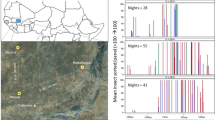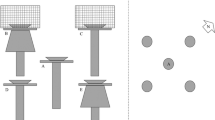Abstract
A five year study of migration of aphids across the southern part of the Baltic Sea is reported. The aphids were caught in a suction trap placed on a lighthouse 50 m from the shoreline. Large sections of the results are presented as case studies i.e. catches of aphids from periods containing at least three consecutive days with a southerly gradient wind. Some periods contained large and diverse catches and it is assumed that aphids regularly cross the Baltic Sea. The catches was largest on days when a cold front passed the trapping site within a period. MoreMyzus persicae were caught on days when the wind was southerly than on days with a northerly wind direction.
Similar content being viewed by others
References
ANDERSSON, K. (1977): BekÄmpningströskel för bladlus i stråsÄd. VÄxtskyddsrapporter Jordbruk 1: 12–22.
BAGGER, O. (1976): Skadedyr på landbrugsplanter. Statens plantepatologiske forsog. Månedsoversigt over plantesygdomme No. 493: 37–44.
BJÖRLING, K. (1949): Virusgulsot hos betor. Sjukdomsbild och inverkan på den svenska sockerbetsskörden. Socker Handl., 5: 119–140.
BROWNING, K. A. (1971): Radar measurements of air motion near fronts. Weather, 26: 320–340.
COCKBAIN, A. J. (1961a): Fuel utilization and duration of tethered flight inAphis fabae Scop. J. exp. Biol., 38: 163–174.
COCKBAIN, A. J. (1961b): Low temperature thresholds for flight inAphis fabae Scop. Entomologia exp. appl., 4: 211–219.
ELTON, C. S. (1925): The dispersal of insects to Spitzbergen. Trans. ent. Soc. Lond., 1925: 289–299.
GLICK, P. A. and NOBLE, L. W. (1961): Airborne movement of the Pink Bollworm and other arthropods. Tech. Bull. U.S. Dept. Agric. No. 1255.
GREENBANK, D. O., SCHAEFFER, G. W. and RAINEY, R. C. (1980): Spruce Budworm (Lepidoptera: Tortricidae) moth flight and dispersal: New understanding form canopy observations, radar and aircraft. Mem. Ent. Soc. Can., No. 110.
HENRICKSON, A. B. (1971): The investigations of the accuracy in numerical computations of horizontal trajectories in the atmosphere. Sveriges Meteorologiska och Hydrologiska Institut: Serie Meteorologi 27.
JOHNSON, C. G. (1967): International dispersal of insects and insect-borne viruses. Neth. J. Pl. Path. 73; Suppl. 1: 21–43.
JOHNSON, C. G. (1969): Migration and Dispersal of Insects by Flight. Methuen, London.
JOHNSON, C. G. and TAYLOR, L. R. (1955): The development of large suction traps for airborne insects. Ann. appl. Biol., 43: 51–61.
KENNEDY, J. S. and BOOTH, C. O. (1963): Free flight of aphids in the laboratory. J. exp. Biol., 40: 67–85.
KENNEDY, J. S. and LUDLOW, A. R. (1974): Co-ordination of two kinds of flight activity in an aphid. J. exp. Biol., 61: 173–196.
KIECKHEFER, R. W., LYTLE, W. F. and SPUHLER, W. (1974): Spring movement of cereal aphids into South Dakota. Environmental Ent., 3: 347–350.
KRING, J. B. (1972): Flight behaviour of aphids. Ann. Rev. Ent., 72: 461–492.
MOERICKE, V. (1955): über die Lebensgewohnheiten der geflügelten BlattlÄuse (Aphidina) unter besonderer Berücksichtigung des Verhaltens beim Landen. Z. angew. Ent. 37: 29–91.
RAINEY, R. C. (1976): Flight behaviour and features of the atmospheric environment. In: Rainey, R. C. (Ed.), Insect Flight, Symp. R. ent Soc. Lond., 7: 75–112.
RAUTAPÄÄ, J. (1976): Population dynamics of cereal aphids and method of predicting population trends. Ann. agric. Fenn. 15: 272–293.
TAYLOR, L. R. (1958): Aphid dispersal and diurnal periodicity. Proc. Linn. Soc. Lond., 169: 67–73.
TAYLOR, L. R., WOIWOD, J. P. and TAYLOR, R. A. J. (1979): The migratory ambit of the hop aphid and its significance in aphid population dynamics. J. Anim. Ecol. 48: 955–972.
TAYLOR, R. A. J. (1979): A simulation model of locust migratory behaviour. J. Anim. Ecol. 48: 577–602.
TOMLINSON, A. I. (1973): Meteorological aspects of Trans-Tasman insect dispersal. New. Zeal. Ent. 5: 253–268.
WALLIN, J. R. and LOONAN, D. V. (1971): Low-level jet winds, aphid vectors, local weather and barley yellow dwarf virus outbreaks. Phytopathology, 61: 68–70.
WIKTELIUS, S. (1977): The importance of southerly winds and other weather data on the incidence of sugar beet yellowing viruses in southern Sweden. Swedish. J. agric. Res., 7: 89–95.
WIKTELIUS, S. (1980): Majsbladlusen, en ny bladlus i korn. VÄxtskyddsnotiser 2–3: 52–53.
WIKTELIUS, S. (1981): Wind dispersal of insects, Grana 20: 205–207.
Author information
Authors and Affiliations
Rights and permissions
About this article
Cite this article
Wiktelius, S. Long range migration of aphids into Sweden. Int J Biometeorol 28, 185–200 (1984). https://doi.org/10.1007/BF02187959
Received:
Revised:
Issue Date:
DOI: https://doi.org/10.1007/BF02187959




